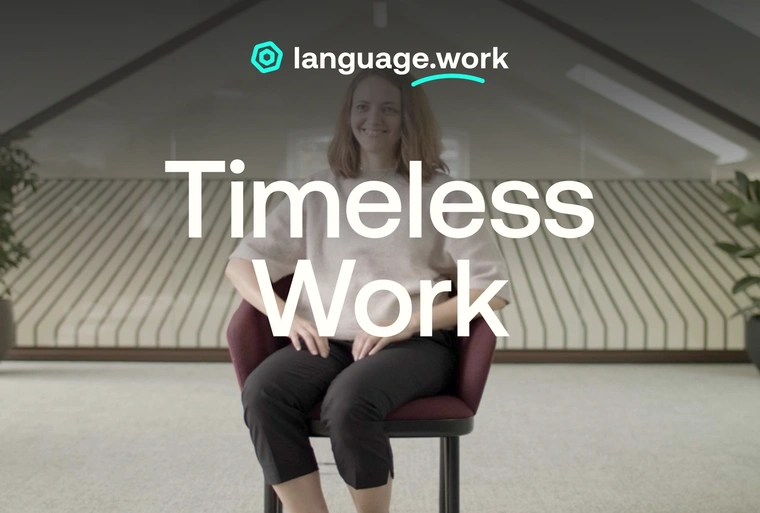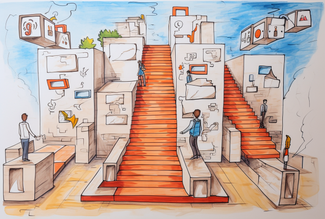
Timeless work — the death of the 9-5
Qatalog recently launched a mini-documentary series examining the staggering pace of change in the workplace, setting out to find better ways of working along the way.
The first two episodes covered the chaos and noise that our modern productivity tools have created and the growing strategic role that operations teams play in enabling increasingly complex workplaces.
The latest episode is all about when we work and how increasing flexibility is rendering the rigid 9-5 workday obsolete.
Visit language.work for the full episode, or read below for some highlights.
Timeless work — the death of the 9-5
Many employers and employees are recognizing that tracking traditional working hours are no longer suitable for modern work. Working on flexible schedules, or asynchronously, has given people a new freedom to choose a work pattern that works for them. However, a recent study by Qatalog and GitLab revealed that over 40% of knowledge workers have still never even heard of the concept of asynchronous work.
So let's start off with what asynchronous work is. It is typically defined as a system where workers complete tasks on their own schedule, without being expected to respond to all messages or emails immediately. And this flexibility in turn gives asynchronous workers the freedom to fit work around their lives. “People are considering the role of work in their lives. And we've seen a shift from ‘how is my life going to fit around work,’ to now ‘how is work going to fit into my life,’” Sheela Subramanian, VP at Slack Future Forum explains.
So what brought about this change?
The pandemic acted as a catalyst, with technology as the enabler, and there is no going back. As Darren Murph, Head of Remote at GitLab puts it, “Now that people are used to working outside of the normal bounds, and they're used to experimenting with different ebbs of ebbs and flows of productivity, I doubt that you'll be able to put that genie back in the bottle.”
Creating a culture that works
For Dr. Oliver Harrison, CEO and founder of Koa Health, the switch to asynchronous and hybrid working has proven to be a positive experiment. So far, the company of 140 employees has seen significant improvements in productivity, team engagement, and even in their net promoter score. A return to a conventional 9-5 in the office would be a backward step.
However, even as companies are slowly understanding and looking to reap the benefits of flexible working, asynchronous working is not everyone’s reality just yet. For many companies, the change involves a significant shift in company culture, one which needs to be intentional and well communicated in order to avoid the pitfalls of “digital presenteeism.”
Siobhan McKeown, COO of HumanMade, defines digital presenteeism as the performative aspect of modern work — “This performance of always being online, of always being available, of always responding to things. There's that need to have that little green light on in Slack so that people can see that you're there.”
According to research from Qatalog and GitLab, this phenomenon impacts 54% of knowledge workers, who feel pressure to show they’re online working. As a result, workers now waste 67 minutes every day, ‘working’ extra hours simply to show they are online.
So, how do we stop the performance? The experts interviewed highlighted three key steps:
- First of all, strive to create an output-focused culture. “Presenteeism was never a great way to measure the results of a business, but it was easier,” Darren Murph tells us. “As teams are more distributed, there is really no such thing as showing up or clocking out. Work can happen as the sun turns, and leaders will come to expect that results are what matters.”
- Secondly, the tone must be set from the top. Sheela Subramanian explains how she used status messages to communicate her core working hours during the pandemic, making it clear that outside of those her role is caring for her two small children. “By showing my humanity, by showing the fact that I had multiple responsibilities, it gave an opportunity for others to feel like they could do the same thing.”
- And the third suggestion, from Daphnee Laforest, founder of Modern Leaders, was to replicate an “open-source” philosophy, used by many software companies long before the pandemic. This is about giving anyone access to the code and allowing them to make suggestions and comments, in their own time. “You see a product evolving created by people who have never met in person, that might not be in the same country or the same time zone.”
The hard truth about technology
While technology has enabled this new way of working, it can also make asynchronous working harder, due to the constant stream of notifications. Qatalog and GitLab research found that the average knowledge worker receives notifications from 6 applications every day, and 73% of workers respond to them outside their working hours. Dr. Oliver Harrison, a neuroscientist by background, tells us why they can be hard to ignore. “The little red dots have been consciously designed to grab our attention and to set off a dopamine reward system in our brain.”
Again, the interviewees had some tips to combat this behavior:
- Configure notifications: Given the power of the little red dot, Dr. Oliver Harrison recommends configuring notifications so they're only active during your chosen working hours. “This is the base for us to really mitigate some of the risks and get the best out of the technology, but avoid some of the pitfalls.”
- Use scheduled send: Another simple but powerful change is the ability to schedule communications across our work tools. As Laila von Albensleben explains, “...not only does new technology allow people to work asynchronously, but it also allows people to be mindful about when people receive that information… with scheduled send, people don't necessarily feel the pressure to always be online and respond immediately.”
- Add breaks into your work calendar: “Guidelines encouraging people to actually schedule breaks in their calendars are critical. It will remind them to let others know that they're not available, and to go outside, or even to have walk-and-talk meetings,” added Laila.
The war for talent
Power in the labor market has recently shifted in favor of employees, who are demanding greater flexibility — and they are willing to quit if they don’t get what they want.
“Companies are having to take quite seriously that people are reevaluating their priorities in life. And perhaps companies have to be a little bit more accommodating than they used to in order to make sure that they retain talent,” Professor Julian Burkinshaw explains.
Qatalog and GitLab research also found that 43% of knowledge workers would consider a lower-paid role if it gave them greater flexibility, a view echoed by Siobhan McKeown.
“In my experience, people are willing to take a lower salary for more flexibility because they aren't just focused on their work, but they want to find balance through their work for the rest of their life. So I see this becoming more and more prevalent.”
One thing is clear. We are living through a monumental change in the way we think about work, and we all have a chance to make our mark on how we want it to play out in the future.
Visit language.work for the full episode.



